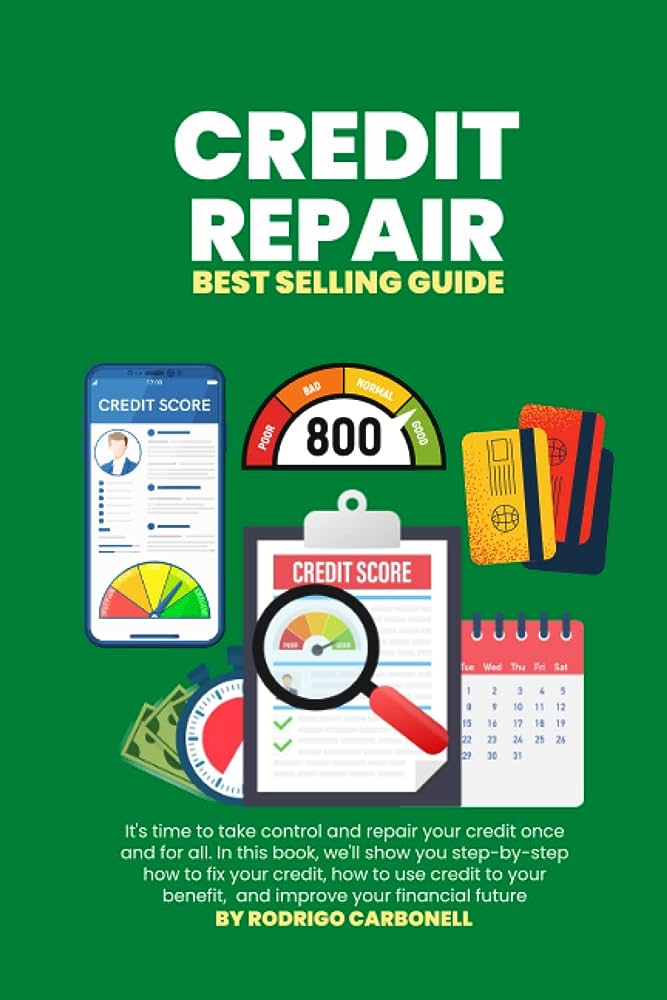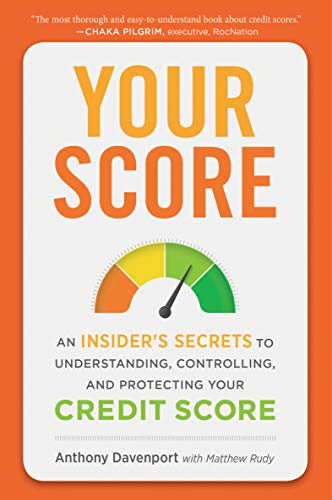In the realm of personal finance, credit repair plays an integral role in shaping individuals’ financial well-being. However, navigating the complexities of credit repair can be daunting, leaving many in desperate need of guidance. Fortunately, a beacon of hope arises in the form of the “Best Credit Repair Book.” Designed to empower individuals with invaluable knowledge and strategies, this book serves as an indispensable resource for those on a quest to restore their creditworthiness. Packed with comprehensive information and expert insights, this book is a must-have for anyone seeking to take control of their financial standing.
Understanding Credit Repair
Credit repair refers to the process of improving or fixing your credit score. A good credit score is crucial for various reasons, such as obtaining loans, renting a house, or even securing a job. Understanding credit repair can help you take necessary steps to improve your creditworthiness and financial stability.
Importance of Credit Repair
Credit repair is essential because it allows individuals to rectify any errors and improve their credit profiles. A low credit score can have a negative impact on your financial options and can make it more challenging to obtain loans or credit cards. By repairing your credit, you can increase your chances of securing better rates and terms, saving money in the long run.
Common Credit Issues
Understanding common credit issues can help you identify and address them effectively. Some of the common credit issues include late payments, high credit utilization, debt collections, and identity theft. These issues can result in a lower credit score and hinder your financial progress. It is crucial to address these issues promptly to prevent further damage to your credit profile.
Benefits of Credit Repair
Repairing your credit can offer several benefits. First and foremost, it can improve your credit score, which opens doors to better financial opportunities. A higher credit score can lead to lower interest rates on loans and credit cards, saving you money in the long term. Additionally, credit repair can provide you with a sense of financial security and peace of mind, knowing that your credit profile accurately reflects your creditworthiness.
Choosing the Best Credit Repair Book
With numerous credit repair books available in the market, choosing the best one can be quite challenging. However, following a systematic approach can help you make an informed decision.
Researching Credit Repair Books
Before selecting a credit repair book, it is essential to conduct thorough research. Look for books that cover a wide range of credit repair topics, provide step-by-step guidance, and are written by reputable authors. It is also beneficial to explore various book summaries, online reviews, and recommendations to understand the book’s contents and credibility.
Customer Reviews and Ratings
Customer reviews and ratings play a crucial role in assessing the quality and effectiveness of a credit repair book. Reading reviews from individuals who have used the book can provide valuable insights into its strengths and weaknesses. However, it is important to consider multiple reviews and evaluate the overall consensus rather than relying on a single opinion.
Author’s Credibility
The credibility of the author is a significant factor to consider when choosing a credit repair book. Look for authors who have expertise and experience in the field of credit repair. Check the author’s background, credentials, and reputation within the financial industry. An author with a strong track record can provide reliable and trustworthy information to guide you through the credit repair process.

This image is property of Amazon.com.
Top Credit Repair Books of All Time
While there are numerous credit repair books available, a few have gained widespread recognition for their comprehensive coverage and effective strategies. Here are three top credit repair books of all time:
Book 1: Title
This book provides a comprehensive guide to understanding credit repair and offers practical strategies to improve your credit score. It covers topics such as credit reports, debt management, and disputing inaccuracies. The book aims to empower readers with knowledge and tools to take control of their credit and financial future.
Book 2: Title
With a focus on step-by-step credit repair, this book takes readers through the entire process from assessing credit reports to negotiating with creditors. It provides actionable tips and advice to achieve tangible results. The book also addresses common credit challenges and offers solutions to overcome them.
Book 3: Title
This book emphasizes the importance of maintaining good credit after the repair process. It provides guidance on credit monitoring, making timely payments, and avoiding new debt accumulation. It offers valuable insights for individuals looking to maintain a positive credit history for the long term.
Key Concepts Covered in Credit Repair Books
Credit repair books typically cover several key concepts that are essential to understand for successful credit repair. Here are some of the key concepts you can expect to find in these books:
Credit Reports and Scores
Understanding how credit reports are generated, what factors influence your credit score, and how to interpret the information in your credit report is fundamental to credit repair. Credit repair books often explain these concepts in detail and provide strategies to improve your credit score.
Debt Management
Dealing with debt is a common challenge for many individuals. Credit repair books offer guidance on managing debts effectively, including creating a budget, prioritizing payments, and exploring debt consolidation options. These books can help you establish a plan to reduce your debt and improve your creditworthiness.
Identifying and Correcting Errors
Credit reports may contain errors, such as incorrect personal information or inaccurate account details. Identifying and correcting these errors is an essential part of the credit repair process. Credit repair books provide guidance on how to identify errors, file disputes with credit bureaus, and navigate the correction process.

This image is property of Amazon.com.
Step-by-Step Credit Repair Process
A step-by-step approach is often followed in credit repair books to guide individuals through the credit repair process. Here are the typical steps involved:
Assessing Credit Reports
The first step in the credit repair process is to obtain and review your credit reports. Credit repair books provide instructions on how to request your reports from credit bureaus and analyze the information within them. This assessment helps identify any errors or negative items that need to be addressed.
Disputing Inaccurate Information
If you find any inaccuracies or errors on your credit reports, credit repair books often provide guidance on how to dispute them. This involves writing dispute letters to credit bureaus, including supporting documentation, and following up on the progress of the dispute.
Negotiating with Creditors
Credit repair books may offer strategies for negotiating with creditors to resolve outstanding debts. This can involve negotiating payment plans, settlements, or even requesting goodwill adjustments. Understanding how to communicate effectively with creditors can improve your chances of reaching mutually beneficial agreements.
Strategies for Building a Positive Credit History
Once you have repaired your credit, it is essential to focus on building a positive credit history. Credit repair books often provide strategies to help you establish and maintain good credit habits. Some common strategies include:
Establishing Good Payment Habits
Paying bills on time is crucial for maintaining a positive credit history. Credit repair books provide insights into creating a payment plan, setting reminders, and automating payments to ensure timely payments.
Maintaining Low Credit Utilization
Credit utilization refers to the percentage of available credit that you actually use. Keeping your credit utilization low can have a positive impact on your credit score. Credit repair books offer strategies for managing credit utilization effectively, such as paying off balances in full or keeping balances below a certain threshold.
Diversifying Credit Types
Having a mix of credit types can showcase your ability to manage different types of credit responsibly. Credit repair books may offer strategies for diversifying credit, such as taking out a small loan or obtaining a secured credit card.

This image is property of Amazon.com.
Credit Repair Resources and Tools
In addition to credit repair books, various resources and tools can assist you throughout the credit repair process. Here are some commonly recommended resources:
Websites and Online Forums
Numerous websites and online forums provide valuable information on credit repair and share experiences and tips from individuals who have successfully repaired their credit. These resources can supplement the knowledge obtained from credit repair books and offer a community to seek advice and support.
Credit Monitoring Services
Credit monitoring services allow you to track changes in your credit reports and receive alerts about any potential suspicious activity. These services can help you stay informed and address any issues promptly. Credit repair books may suggest reputable credit monitoring services that offer comprehensive coverage and reliable alerts.
Financial Planning Software
Financial planning software can assist you in managing your finances effectively and staying organized throughout the credit repair process. Some software options offer credit score tracking, budgeting tools, and debt management features, which can complement the strategies outlined in credit repair books.
Common Mistakes to Avoid in Credit Repair
While credit repair can be an effective way to improve your credit, there are common mistakes that you should avoid. Recognizing and steering clear of these mistakes can help you achieve better results in your credit repair journey. Here are some of the common mistakes to avoid:
Disputing Valid Information
One common mistake is disputing valid information on your credit reports. Credit repair is primarily focused on correcting errors and inaccuracies, not contesting accurate information. Disputing valid information can harm your credibility and create unnecessary complications.
Ignoring Legal Rights and Protections
As a consumer, you have legal rights and protections under various laws, such as the Fair Credit Reporting Act (FCRA) and the Fair Debt Collection Practices Act (FDCPA). Ignoring or not utilizing these rights can hinder your credit repair progress. Credit repair books often emphasize the importance of understanding and exercising your legal rights.
Falling for Credit Repair Scams
Credit repair scams are unfortunately prevalent in the industry. These scams often promise quick and unrealistic results while charging hefty fees. It is crucial to be aware of red flags and conduct thorough research before engaging with any credit repair service or program. Credit repair books can provide guidance on identifying and avoiding scams.

This image is property of Amazon.com.
Challenges and Limitations of Credit Repair
Credit repair is not a quick fix and requires time and patience to achieve significant results. Understanding the challenges and limitations can help you set realistic expectations and prepare for potential obstacles. Some of the challenges and limitations include:
Time and Patience Required
Credit repair is a gradual process that may take months or even years to fully adjust your credit profile. It requires consistent efforts, such as disputing inaccuracies, paying off debts, and establishing positive credit habits. Patience is key when it comes to credit repair.
Impact on Future Credit Applications
While credit repair can improve your credit score, it does not guarantee immediate approval for future credit applications. Lenders consider various factors when deciding whether to extend credit, and your credit history is just one part of the equation. It is important to manage your expectations and be aware that credit repair may not instantly grant you access to all types of credit.
Laws and Regulations
Navigating through credit repair requires knowledge of relevant laws and regulations. Laws, such as the FCRA and the FDCPA, govern the credit reporting and debt collection processes. Complying with these laws and understanding your rights can be complex, but credit repair books can offer guidance on the legal aspects of credit repair.
Maintaining Good Credit After Repair
After successfully repairing your credit, it is crucial to maintain good credit habits to sustain your progress. Here are some essential steps to consider:
Monitoring Credit Reports Regularly
Continue monitoring your credit reports regularly to ensure accuracy and promptly address any potential issues or errors. Staying vigilant can help you maintain a positive credit profile and catch any discrepancies early on.
Making Timely Payments
Consistently making timely payments is a critical factor in sustaining good credit. Set reminders, automate payments, or establish a budget to ensure you meet your payment obligations promptly. This practice will contribute to a positive payment history and strengthen your creditworthiness.
Avoiding Accumulation of New Debt
While it may be tempting to utilize newly available lines of credit, it is important to use credit responsibly. Avoid accumulating unnecessary debt and keep your credit utilization low. This habit will demonstrate financial discipline and contribute to a positive credit history.
In conclusion, understanding credit repair is vital for individuals looking to improve their creditworthiness. Choosing the best credit repair book is a crucial step in acquiring knowledge and strategies to repair credit effectively. Credit repair books provide valuable insights into credit reports, debt management, and the dispute process. By following a step-by-step credit repair process, individuals can address credit issues, negotiate with creditors, and build a positive credit history. However, credit repair does have limitations and challenges that must be acknowledged. Maintaining good credit after repair requires ongoing vigilance, including monitoring credit reports, making timely payments, and avoiding new debt accumulation. With the right resources and strategies, individuals can embark on a successful credit repair journey and achieve long-term financial stability.

This image is property of Amazon.com.
